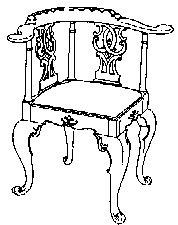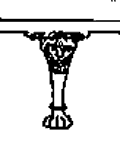Georgian Period Furniture
English Period Furniture – Georgian Period 1714-1806
The Georgian Period is divided into three:
Early Georgian 1745-1780
Mid Georgian 1730-1750’s
Late Georgian 1750-1830
Furniture had previously had its origins in the court and worked its way down, but George I brought a dull and tarnished feeling to the court and only few developments took place in the households of the rich.
Separate designers distinguished themselves in the late Georgian Period, this is known as the “The Golden Age of Furniture”. The designers were:

George 11 Corner Chair c. 1740, whorl feet
Thought was changing during these periods and the house and its contents started to be considered as two parts of one whole. Architects were now turning their hand to furniture design.
Early Georgian
Mahogany
The importation of Mahogany in the 1720’s firstly from Cuba, and later from Honduras generally replaced Walnut as the main timber for furniture making. Mahogany had much better characteristics, it was not attacked by worm, it carved with a crispness (which led to a revival in carving) and it was less likely to shrink and twist.
Furniture was now being imported from other countries, China and France.

Furniture was designed to match the Neo-Palladian architecture and was on a grand scale. William Kent, an architect, designed heavy showy pieces of furniture for the rich market.
They were designed for mansions and palaces and were often enormous gilded pieces of bad taste. Bookcases had pediment tops which imitated the exterior of the house.
It was the designers that followed this period that developed the style, now considered typically Georgian.
Early Georgian Furniture Characteristics
- George II Chair – splats carved in honeysuckle motif.
- Corner chairs for reading and writing some had candlesticks.
- Whorlfeet.
- William Kent Chair.
- Similar lines to Queen Anne chairs. Solid vase splat but heavier construction.
- Baroque style of William Kent.
- Gessowork. A paste of chalk and parchment size. It is applied to part finished wood, carved in fine detail, an easier task than with wood, then gilded.
- Crimson and gold upholstery pieces with the Greek key pattern around the seat frame.
- Carved lions masks and paw feet.
- Double chair back form.
- Concertina extension tables with two or three tops.
